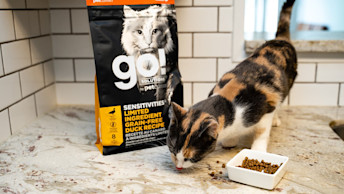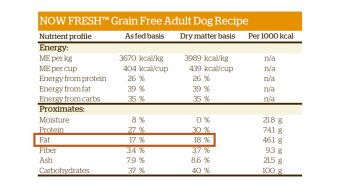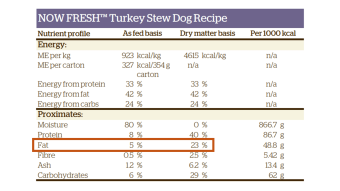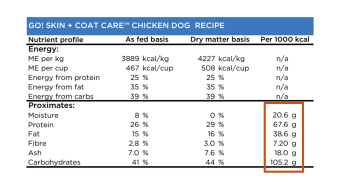July 3, 2021
Understanding Nutrient Profiles

Have you ever wondered how we go about creating nutritious and delicious recipes for dogs and cats? From concept to production, pet food formulation takes many months and an entire team of people to develop just the right recipe. We pride ourselves on crafting unique recipes designed to meet the needs of dogs and cats (and cats and dogs) of all different shapes, sizes, backgrounds and ages.
When formulating a pet food, the key is choosing the right combination of ingredients necessary to meet the nutrient requirements of the animal.
Our team of expert nutritionists make sure that each Petcurean recipe contains every nutrient your pet needs to sustain and nourish its life.
When creating a recipe, we must ensure that it contains the correct nutrient balance to meet the requirements of a pet, and this requires great attention to detail. Each piece of kibble must contain all the nutrients required to keep a pet healthy and sustain life. Ingredients are the vehicles for providing these nutrients, but ultimately the nutrient levels in a recipe are what is most important.
Association of American Feed Control Officials (AAFCO) Nutrient Recommendations
If you flip over a bag of Petcurean kibble, you will see a statement indicating that the food is formulated to meet certain nutrient levels for a specific species and life stage.
Here is an example:
"Go! Solutions Skin + Coat Care Chicken Recipe is formulated to meet the nutritional levels established by the AAFCO Dog Food Nutrient Profiles for All Life Stages including growth of large size dogs (70lbs or more as an adult)."
In the pet food world, these statements indicate if a food is “complete and balanced”. For a recipe to be designated as complete and balanced, it must meet all the nutrient requirements of a pet. An organization called the Association of American Feed Control Officials, or AAFCO, publishes specific nutrient recommendations for dogs and cats for two specific life stages: growth & reproduction; and adult maintenance. These guidelines incorporate the most current information on optimal nutrition for dogs and cats based on scientific research. Meeting these AAFCO nutrient targets provides reassurance that the food meets the nutritional requirements of the animal. Therefore, if the food states that it is formulated to meet the AAFCO nutrient profiles, then it is complete and balanced and must contain all the nutrients needed to be a pet’s only source of nutrition.
The AAFCO nutrient profiles are also helpful since they report the minimum recommendation of each nutrient required for a pet. So, if your pet requires a food that is high or low in a specific nutrient, you can compare the nutrient level in the food to the minimum and maximum values published in the AAFCO nutrient profiles. The AAFCO nutrient profiles are not readily available to the public, so if you need help, please reach out to our customer care team, as our Health and Nutrition Specialists have access to this information.
Understanding the Nutrient Makeup of Our Recipes
Now if nutrient levels are so important, how does one go about finding the perfect recipe for their pet? Well, on the Petcurean website, you can find our nutrient profiles that outline the specific nutrient makeup for every Now Fresh, Go! Solutions and Gather recipe. These profiles are a convenient way to determine the amount of each nutrient in your pet’s food.
When looking at our nutrient profiles, you will notice that nutrient levels are presented in three different ways: on a dry matter basis; on an as fed basis; and on a per kilocalorie basis. But, what do these mean?
Well, dry matter is the value for a nutrient assuming all moisture in the food is removed. Dry matter is used because it provides information about the nutrient content of foods on a uniform basis. Nutrient levels in foods with different moisture contents (e.g. wet versus dry recipes) can be directly compared when reported on a dry matter basis. Also, AAFCO publishes their nutrient recommendations on a dry matter basis, so this column allows you to directly compare a recipe to the AAFCO nutrient profiles and be sure that the food is complete and balanced.
On the other hand, ‘as fed’ is the value for a nutrient as it is found in the food itself, including the moisture content. This is also as you would feed it to your pet. This information is helpful if you wanted to calculate how much food you need to feed to provide your pet with a specific amount of a particular nutrient.
Reading the label of a pet food bag does not always tell you all of the information you need to know and that’s why the nutrient profiles are so important. Say you need a lower fat food to help your pet shed a few pounds and you’re trying to decide between two foods: NOW FRESH Recipe for Adult Dogs kibble and NOW FRESH Turkey Stew for Dogs. The Guaranteed Analysis on the bag is reported on an ‘as fed’ basis, but when comparing foods with different amounts of moisture, it’s important to compare nutrient levels on a ‘dry matter’ basis. This is where the nutrient profiles come in handy; we’ve already done all of the math for you! The NOW FRESH Turkey Stew has a fat content of 23% on a dry matter basis, while the NOW FRESH Adult kibble has a fat content of 18%. In this situation, you would choose the NOW FRESH Adult kibble recipe because it’s lower in fat.

NOW FRESH Recipe for Adult Dogs kibble Nutrient Profile example

NOW FRESH Turkey Stew for Dogs Nutrient Profile example
Since animals must eat food in an amount that meets their energy requirements, it’s important to know nutrient intake on a ‘per calorie’ basis. That’s why we also conveniently provide nutrient levels on a “Per 1000 kcal” basis in every nutrient profile. This column shows you the amount of each nutrient your pet would consume if they were to eat 1000 calories of food. For example, if your dog ate 1000 calories of Go! Solutions Skin + Coat Care Chicken Recipe with Grains for Dogs, they would receive 67.6 grams of protein, 38.6 grams of fat, and 4.63 grams of fibre. Just like nutrient levels on a ‘dry matter basis’, the ‘per calorie basis’ allows direct comparison of nutrient levels between foods with different moisture levels. AAFCO also reports nutrient requirements on a per calorie basis.

This column shows you the amount of each nutrient your pet would consume if they were to eat 1000 calories of food.
Nutrients vs Ingredients
Pet food formulation is a detailed process that involves balancing different types and amounts of ingredients to meet the specific nutrient requirements of a pet.
When choosing a pet food, it is key to remember that it is the nutrients in a recipe that a pet requires, not individual ingredients. Ingredients are the vehicles for providing these nutrients.
Formulating diets with different nutrient levels can be accomplished using a wide variety of ingredients including fresh meats, meat meals, eggs, grains, fruits, vegetables, vitamins and minerals. That is why Petcurean is able to provide such a large portfolio of recipes spanning a wide range of nutrient profiles. In the end, when evaluating different recipes, it is the nutrient levels and their balance that speak the most about the integrity of the food. The nutrient profile tells you a lot more about a food than the ingredient panel. But, we know that reading a nutrient profile is not a simple feat! Don’t despair if you need a bit of help. Our team of Health and Nutrition Specialists are available if you have any questions. Get in touch or call 1.866.864.6112.
This blog was originally published on October 21, 2019. Last revised July 2021.



